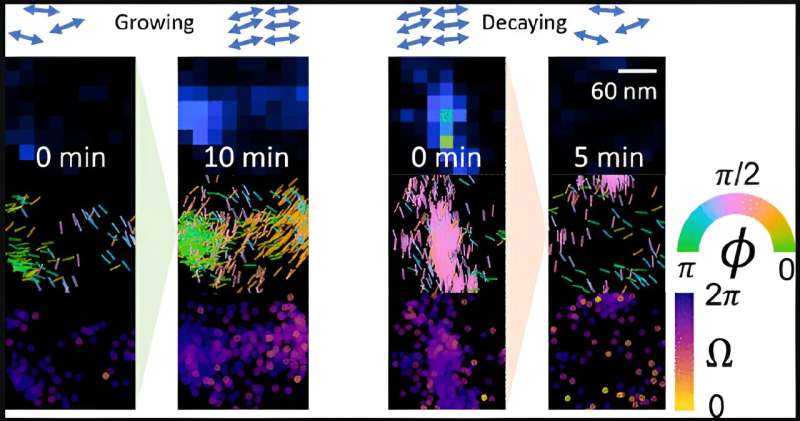
Credit: Nano Letters (2024). DOI: 10.1021/acs.nanolett.4c01263
Beta-amyloid (A-beta) aggregates are tangles of proteins that are associated with neurodegenerative diseases such as Alzheimer’s disease. Despite their constant presence in the spotlight, however, researchers have not been able to fully understand how beta-amyloid aggregates form and break down.
“How A-beta behaves in different environments, including the human brain, is difficult to pin down,” said Brian Sun, a Washington University in St. Louis alumnus who is now an MD and PhD student at the School of Medicine. “We don’t yet fully understand how the protein grows and breaks down.”
This is about to change thanks to recent research. published In Nano Letters by Sun with colleagues in Matthew Lew’s lab in the Preston M. Green Department of Electrical and Systems Engineering in WashU’s McKelvey School of Engineering.
In a novel work, Sun and his colleagues were able to measure the assemblies of amyloid fibril beta sheets, the underlying beams of the protein conglomerate, as they were changing. Previous high-resolution microscopy studies obtained only static images.
“We wanted to look specifically at the dynamics of the underlying structure of A-beta that might be responsible for the changes we observe, not just changes in the overall shape,” said Sun, first author of the paper.
Lew used Lego bricks in an analogy, noting that current imaging technology shows you the complete Lego building but not a glimpse of how the individual bricks are arranged.
“Individual proteins are constantly changing in response to their environment,” Associate Professor Lew said. “It’s like some Lego bricks changing the shape of other bricks. The evolution of protein architecture and the aggregates that come together drives the complexity of neurodegenerative diseases.”
The Lew lab has developed a new type of imaging technology that allows researchers to see the orientation and other minute details of previously invisible nanostructures in biological systems. Their technique, single-molecule orientation-localization microscopy (SMOLM), uses flashes of light from chemical probes to visualize the peptide sheets underlying Aβ42, a type of A-beta peptide.
Using SMOLM allows them to look at the individual orientation of the underlying beta sheets to see the relationship between their organization and how it relates to the overall structure of the amyloid protein.
Several ways to renovate
The Aβ42 protein is constantly evolving, and the first step is to try to find a method, model or scheme of action to predict the behavior of the protein.
Now that the Lew lab can make these measurements, they’ve made some intuitive observations and found some surprises hidden in the architecture of the amyloid-beta protein.
As expected, stable Aβ42 structures tend to retain stable underlying beta sheets; growing structures have underlying beta sheets that become more defined and rigid as growth continues. Decaying structures have increasingly disordered and less rigid beta sheets. But they also discovered more than one way that Aβ42 can renovate itself.
“There are several different ways for Aβ42 structures to remain stable, or to grow and break down,” Sun said.
The researchers also found that Aβ42 can grow and degrade in unexpected ways. For example, Aβ42 can grow and degrade in ways that preserve the underlying structure; sometimes there is growth where peptides accumulate, but the orientations of the underlying beta sheets do not change. In other cases, Aβ42 undergoes “stable degradation,” where the opposite happens, that is, the peptides disappear, but the beta sheet structure remains.
Finally, Aβ42 beta sheets sometimes reorganize and change orientation without causing immediate changes in overall shape. These nanostructural reorganizations may predispose to future large-scale remodeling.
“Because SMOLM can track the underlying organization of Aβ42 and not just its shape, we can see different types of remodeling subtypes that are not visible by orientation-free and diffraction-limited imaging modalities,” Sun said.
If all this sounds a bit vague, keep in mind that this is the first attempt to analyze these ever-changing nanoscale structures. It’s all the more remarkable that Sun did this work while juggling COVID-19 lockdown restrictions and his undergraduate program at WashU, which he completed in three years. It paves the way for him and others to truly understand amyloid architecture.
During the graduate phase of his MD/PhD training, Sun plans to design nanoscale imaging systems and sensors that could reveal the hidden mechanisms of hard-to-treat diseases.
Sun thanks McKelvey Engineering and the Lew Lab for the rigorous training that made this study and academic journey possible, and MSTP for supporting him in continuing his research after graduation. “I’m really glad I went through this journey,” he said.
More information:
Brian Sun et al, Single-molecule orientation imaging reveals nanoarchitecture of growing and decomposing amyloid fibrils, Nano Letters (2024). DOI: 10.1021/acs.nanolett.4c01263
Quote:Innovative microscopy reveals amyloid architecture, could provide insights into neurodegenerative diseases (July 19, 2024) retrieved July 19, 2024 from https://phys.org/news/2024-07-microscopy-reveals-amyloid-architecture-insights.html
This document is subject to copyright. Apart from any fair dealing for the purpose of private study or research, no part may be reproduced without written permission. The content is provided for informational purposes only.